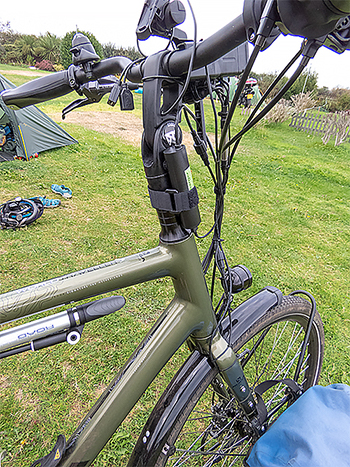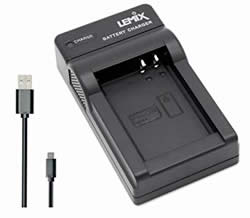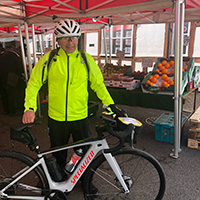Charging electronic gadgets
These days we seem to be taking more and more electronic gadgets with us on tour. In some respects we would like to do without them and in some ways obviously we could, but we do like taking photos as we do have elderly parents who like to know they can keep in touch with us, Frank likes to read her Kindle and the GPS has been useful. All of these gadgets have batteries that obviously need charging on a regular basis.
The obvious way to charge these gadgets is to use the mains chargers that they came with and plug them into wall sockets at campsites. However this is not always possible and especially difficult if you are wild camping! We have tried various methods of charging other than using the mains.
Solar Panels
 We had tried solar panels in the past but without great success, however that was back in 2004 and solar panel technology has moved on since then and we have been encouraged to give them a go again by David from Gadansk who contacted us on our Facebook page:
We had tried solar panels in the past but without great success, however that was back in 2004 and solar panel technology has moved on since then and we have been encouraged to give them a go again by David from Gadansk who contacted us on our Facebook page:
"Nowadays, you can get a 16W folding solar panel for around £40. One of the best is from RavPower - it's light and also waterproof. I used it together with a 10000 mah power pack when I was touring in Scotland last summer. It absolutely does not need direct sunlight to charge - even on totally overcast days, you get enough current to top up your power pack. Admittedly, when it rains, you don't get any charge at all. If you have a lot of gadgets with you, then a solar panel might not be sufficient. I had my phone, my Garmin GPS, a small camera and a tablet. I managed easily for a week, even though it rained solidly for two days - it was Scotland, after all! My point is that for quite a modest outlay (£40 for the panel and £20 for the power pack) I had a system that was enough for my needs. If you want to see how I rigged the solar panel up to the bike, see the photo attached."
For our Sweden and Denmark tour in 2018 we decided to invest in a couple of solar panels to go on the back of the bikes and to charge devices up at the campsite. These worked really well especially with the hot dry summer that we had in central Europe in 2018. It will be interesting to see how they perform in a more cloudy summer.
Wind Chargers
We have also tried wind chargers such as the Hymini. It sounds a nice idea, as you cycle along the air rushing through the mini turbine charges a small battery, which you can then use to charge your mobile devices. The Hymini may output a charging current, but if you read the small print it isn't enough to charge a phone or it's internal battery from flat. We have had two of these, which we used on two separate 4-week tours in Iceland. The first one didn't really charge anything very well so we sent it back and they replaced it. Unfortunately the second one again didn't charge anything with any success and that was with 4 -5hrs of cycling a day well above the 9mph they recommend. When you are wild camping you also can't top it up from the mains easily to then trickle charge the battery as you go along, which we think is the way they intend it to be used.
Dynamos
 The best success we have had with charging electronic gadgets other than obviously using the mains chargers is to use dynamos. Unfortunately the bottle dynamos that run on the side of the wheel don't give out enough power but the hub dynamos do. We have fitted Schmidt SON 28 Dynohubs on the front wheels of our bikes that we use to run Busch & Müller front and rear lights. By connecting the dynohub to a USB charging device they really do work well as a charging source. There are several dynamo charging devices on the market and Alee Denham's excellent site cyclingabout.com has a very good list of all the current USB chargers available to the touring cyclist along with some good indications as to their charging abilities. Like anything you get out what you put in therefore you will find that most dynamo chargers will start to effectively charge when you are doing at least 8-9mph, therefore you need to keep up a good average speed to get charge from a dynamo hub.
The best success we have had with charging electronic gadgets other than obviously using the mains chargers is to use dynamos. Unfortunately the bottle dynamos that run on the side of the wheel don't give out enough power but the hub dynamos do. We have fitted Schmidt SON 28 Dynohubs on the front wheels of our bikes that we use to run Busch & Müller front and rear lights. By connecting the dynohub to a USB charging device they really do work well as a charging source. There are several dynamo charging devices on the market and Alee Denham's excellent site cyclingabout.com has a very good list of all the current USB chargers available to the touring cyclist along with some good indications as to their charging abilities. Like anything you get out what you put in therefore you will find that most dynamo chargers will start to effectively charge when you are doing at least 8-9mph, therefore you need to keep up a good average speed to get charge from a dynamo hub.
We originally used the Busch & Müller 'e-werk' which provided a variable voltage (2.8 to 13.3 V) and current (0.1 to 1.5 A). The e-werk did us well for several years although we did have to replace the cache batteries and on one occasion I did forget to change the voltage from 12v to 5v and I fried a phone battery fortunately it didn't affect the phone. On our tour in Denmark in 2017 one of the wires came away from the main unit (apparently this is a common fault) and we had to replace it. Following the problems with remembering to change voltage on the multi voltage e-werk we decided to review the way we charged devices and decided to go all USB (see our current set up below).
This combination of kit may seem a serious out lay of money but it is well worth it as we have found it to be the most dependable system that will work in all weathers. We have successfully charged mobile phone, camera and rechargeable AA batteries from flat on tour. To give you an idea, we can easily charge a 2400mAh phone battery from flat in about 4- 5 hrs of moderately paced cycling. If you are wondering about dynamo drag by the laws of physics there will be some, however it must be quite small as we haven't experienced anything noticeable.
Rechargeable Power Packs
 One thing we have found very useful particularly when doing a lot of wild camping is to use a rechargeable Power Pack as a charger. There are various small versions available such as the power monkey which have only a small capacity, but if you are out for any length of time wild camping and have several batteries that need charging what you really need is something larger with at least a 18000 to 26000mAh capacity. Look for a power bank that has at least 3 USB charging ports so that you can charge several items at a time.
One thing we have found very useful particularly when doing a lot of wild camping is to use a rechargeable Power Pack as a charger. There are various small versions available such as the power monkey which have only a small capacity, but if you are out for any length of time wild camping and have several batteries that need charging what you really need is something larger with at least a 18000 to 26000mAh capacity. Look for a power bank that has at least 3 USB charging ports so that you can charge several items at a time.
If we are going on a tour where we know we will be doing a lot of wild camping we take a RAVPower Xtreme Series 26800mAh Portable Charger. At around 456g in weight this may seem like a lot of extra weight to carry, however we can charge it off the dynamo or the solar chargers and if you are wild camping for several days with a full charge it will charge our phones, radios, GPS and camera batteries.
Our personal charging set up
For our last summers tour to Denmark in 2018 we decided to review our charging gear in the light of the demised e-werk. As most things such as the phones, GPS, Kindle and iPad used 5v USB it seemed sensible to go all USB. The only thing that used 12v were the Camera battery charger, fortunately we found a good USB camera charger that was lightweight and would charge our camera batteries.
Set out below are the charging devices that we use to charge our electronic devices.
VeloCharger Dynamo USB charger These USB chargers are permanently attached to our touring bikes and are linked to the Schmidt SON 28 Dynohubs on the front wheels of our bikes. On my bike I use the charger to charge my phone solely and Frank uses her charger to keep either her Samsung phone, Kindle or iPad charged. |
 |
Syncwire Solar Charger, 24W Dual USB Port Solar Panel Charger These 24W solar chargers fit nicely over the back of our rear panniers and are kept on by some bungee cord attached to the rear racks by plastic clips. What ever device that needs to be charged is placed in one of the rear panniers and connected to the panel via a USB cable. When we get to the campsite the panels are either hung on the bikes or the tent in the late afternoon and evening sun to charge up our devices. |
 |
RAVPower 60W 6-Port USB Charging Station Very useful piece of kit for charging up to 6 device at any one time, therefore no need to bring individual chargers for each device. Great for charging up at the campsite where there are limited sockets, we can charge up our two radios, two phones, Kindle, iPad, GPS or a camera battery. Because it has the universal C7 power cable connector we can take either a UK power cable or a continental power cable depending on where we are touring. |
 |
Lemix (NB10L) Ultra Slim USB Charger This neat little USB camera battery charger only weighs 32g. Fortunately both Frank's and my Canon cameras use the same batteries so we only need to carry one charger. |
 |
 The photo the right shows the RAVPower 60W 6-Port USB Charging Station on a windowsill in a kitchen on a Danish campsite. We were charging 2 power banks, 2 radios and my smartphone whilst we are cooking our evening meal.
The photo the right shows the RAVPower 60W 6-Port USB Charging Station on a windowsill in a kitchen on a Danish campsite. We were charging 2 power banks, 2 radios and my smartphone whilst we are cooking our evening meal.





































 The Celtic Cycling Circle
The Celtic Cycling Circle Cycling alongside the Grand Union Canal
Cycling alongside the Grand Union Canal 5 Essential Items to Take with You on Your First Cycling Tour
5 Essential Items to Take with You on Your First Cycling Tour Favorite Cycling Destinations: Sardinia
Favorite Cycling Destinations: Sardinia Pamir to Karakoram- cycling the highways on the roof of the world
Pamir to Karakoram- cycling the highways on the roof of the world 4 Wheels 2 Hearts 1 World - A Day in Our lives
4 Wheels 2 Hearts 1 World - A Day in Our lives Koga E-Worldtraveller - e-bike review
Koga E-Worldtraveller - e-bike review Ten tips for tandem cycle touring
Ten tips for tandem cycle touring colmandsamstreks - Two Beginners in France
colmandsamstreks - Two Beginners in France